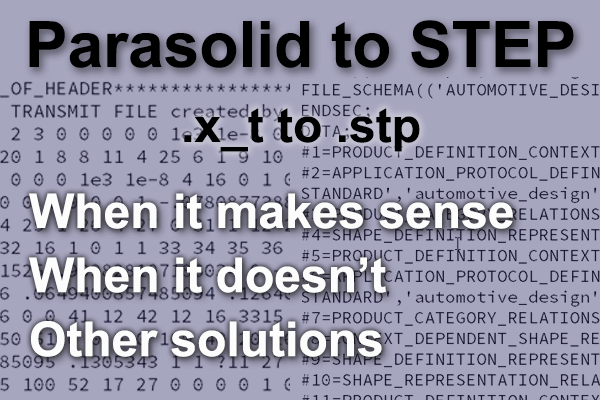 Parasolid to STEP translation is essentially moving from a geometric modeling kernel to a neutral CAD format.
Parasolid to STEP translation is essentially moving from a geometric modeling kernel to a neutral CAD format.
Parasolid is the one of the most popular geometric modeling kernels in use today, and is the next best format to use when converting from a Parasolid-based CAD application.
The best format is always the native CAD format. Parasolid to STEP can also appear as .x_t to .STP or .x_t to .STEP.
An Illustration of X_T to STP
Let’s say you are working with some CAD data that originally came from Solidworks, NX or Solid Edge (all CAD systems that use Parasolid as their geometric modeling kernel). You need to bring the Parasolid data into a CAD-related application that only reads STEP. In this scenario, Parasolid to STEP makes good sense.
Keeping the Format in Parasolid
On the other hand, if the CAD-related application reads Parasolid files, you’d be better off using the Parasolid file directly; and if the CAD-related application is actually based on the Parasolid geometric modeling kernel, such as is the case with Mastercam and many other solutions, there’s even more reason to avoid STEP, and use only the Parasolid file.
See which CAD systems and tools use Parasolid and other kernels in the Geometric Modeling Kernels Reference.
Going Native
Finally, if you have access to the original, native SOLIDWORKS, NX or Solid Edge files and the CAD-related application you are bringing the data into reads those files directly, you’re best off using the native formats and avoiding Parasolid and STEP altogether. For example, if you are using an NX-based machining package you’d be better off getting the original NX file from the customer.
Read more about how to tell what format is best for different situations in the articles The CAD Format Ladder Part 1 and The CAD Format Ladder Part 2.
Use a Good STEP Translator
If you are going to translate from X_T to STEP, make sure to use a good translator. Unlike the translators for geometric modeling kernels, there is a lot of latitude in how a STEP translator can be built. Not all translators are created equal, and oftentimes the STEP translators built into CAD applications are not the highest quality.
The other factor is that you have to consider not only the STEP translator you are using to convert TO STEP, but the translator that is reading the STEP file in the CAD-related application; using two different STEP translators presents twice the opportunity for a bad STEP translation to degrade your CAD data.
TransMagic’s STEP translator is purpose-built to provide the best possible STEP read/write capability in the industry, with the capability to read, recognize and write not only spline-based geometry, but all NURB geometry (essential for properly reading CATIA files) as well as analytic geometry such as cones, cylinders, planes, lines and arcs.
Test Drive TransMagic
You can test drive TransMagic SUPERVIEW, along with MagicHeal and MagicCheck Add-Ons for 7 days at no cost – just click this link to get to the free eval. If you need to be able to write CAD formats to do a proper eval, let us know at sales@TransMagic.com.
